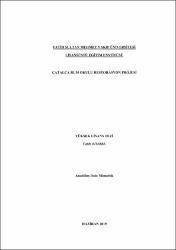| dc.contributor.author | Arama, Fatih | |
| dc.date.accessioned | 2019-10-03T11:14:40Z | |
| dc.date.available | 2019-10-03T11:14:40Z | |
| dc.date.issued | 2019 | en_US |
| dc.identifier.citation | ARAMA, Fatih, Çatalca Rum Okulu Restorasyon Projesi, Fatih Sultan Mehmet Vakıf Üniversitesi Lisansüstü Eğitim Enstitüsü Mimarlık Anabilim Dalı, Yayımlanmamış Yüksek Lisans Tezi, 2019. | en_US |
| dc.identifier.uri | https://hdl.handle.net/11352/2968 | |
| dc.description.abstract | Bu tez çalışmasında, İstanbul’un Çatalca İlçesinde, Fetih Caddesi ile Siper Çıkmazının kesiştiği noktadaki bir bahçe içerisine konumlanmış olan Çatalca Rum Okulu ele alınmıştır. Çalışmanın ana amacı, yapının günümüzdeki durumunun belgelenmesi, özgün olarak yapıldığı dönemdeki durumunu elde edilen bilgi ve belgeler doğrultusunda saptamak ve yapının tarihsel gelişim sürecini incelemek olmuştur. Aynı zamanda yapı bilimsel müdahale teknikleri ile korunarak özgün plan kurgusuna uygun olarak hazırlanan yeni işlev doğrultusunda gelecek nesillere ortak kültürel miras olarak bırakılması için korumaya ilişkin restorasyon projesi hazırlanmıştır.
Özgün isminin Fotakios Skoli (Φωτάκειος Σχολή) olduğu bilinen Çatalca Rum Okulu, Rum cemaatinin büyük hayırseveri Foti Anastasiadi’nin eğitime harcanması için bıraktığı mirasının gelirlerinin bir bölümü ile kurulmuş ve 1910 yılında faaliyete başlamıştır. Cepheleri Neo-klasik üslupta düzenlenen yapı, zaman içerisinde Cezaevi, Hükümet Konağı, İmam Hatip Okulu gibi birçok işlev değişikliği yaşamıştır. Günümüzde yapı, 1985 yılında yapılan ve iç şemasının tamamen değiştiği bir onarımla Jandarma Hizmet Binası olarak kullanılmaktadır.
Tezin ilk bölümünde çalışmanın amacı, kapsamı ve kullanılan yöntemler ele alınmıştır. İkinci bölümde ise, Çatalca Rum Okulu’nun bulunduğu çevreden, tarihsel gelişim sürecinden, doğal, tarihi ve kültürel varlıklarından, Rumların Çatalca’da yaşadıkları semtlerden, Çatalca’daki Rum eğitim sisteminden, Çatalca ve yakın çevresindeki BOA arşiv kayıtlarında bulunan Rum okulu projeleri anlatılmıştır. Üçüncü bölümde Çatalca Rum Okulu’nun tarihçesi ve yasal durumundan bahsedilmiş, yapının mimari özellikleri ve mekân tanımlamaları yapılmış, yapım tekniği ile malzeme özellikleri belirlenmiş, mimari ögeler, yapıdaki bozulma ve nedenleri araştırılmıştır. Dördüncü bölümde, yapıdaki restitüsyon sorunları ve ayırt edilen dönemler, restitüsyona ışık tutan belgeler, ikinci bölümde incelenen Rum okullarının mimari karakterleri ve benzer yapılar ele alınarak yapının, vaziyet planı, plan ve cephe restitüsyonları hazırlanmıştır. Beşinci bölümde, yapının kullanımı için yeni fonksiyon önerisi yapılmış, onarıma ilişkin müdahaleler ile restorasyon projesi hazırlanmıştır. | en_US |
| dc.description.abstract | In this thesis, Çatalca Greek School that is located in a garden which is situated at the intersection of Fetih and Siper Street, is surveyed. The main purposes of the thesis can be identified as follows: i. the investigation of the current state of the structure, ii. obtaining its original status from construction to usage terms according to the available information and documentations, iii. investigation of the historical usage process of the structure. In addition to these, it is aimed to be preserved as a cultural heritage for the next generations with the new function prepared in accordance with the original plan scheme, according to scientific intervention techniques.
Çatalca Greek School, which was originally named as Fotakios Skoli (Φωτάκειος Σχολή), was founded in 1910 with a portion of the revenues of the legacy left by the great benefactor Foti Anastasiadi the for education of the Greek community. The structure whose façades are organized in neo-classical style, has undergone many functional changes such as prison, government house and imam hatip school. The structure was subjected to a complete renovation of the interior scheme in 1985 and now used as the Gendarmerie Service Building.
In the first part of the thesis, the aim of the study, its scope and the methods that are used to individuate the subject is described briefly. In the second part, the environment of the Greek School, its historical development process, the natural and historical cultural assets, the living spaces of Greeks in or around Çatalca, the functions and legal status of the Greek Schools and the Greek School projects that are found in the BOA archives are examined respectively. In the third part, the history and legal status of Çatalca Greek School is explicated and architectural properties of structure and venue definitions are made. In addition to these; construction technique of the structure is investigated, material characteristics are identified, and architectural constituents, structural deterioration and their reasons are examined. In the fourth part, the situation, plan and facade aspects of the building were prepared in the light of the documents that shed light on the restitution project. In the fifth part, a new function is proposed for the use of the structure and a restoration project is prepared with the interventions related to the repair. | en_US |
| dc.language.iso | tur | en_US |
| dc.publisher | Fatih Sultan Mehmet Vakıf Üniversitesi, Lisansüstü Eğitim Enstitüsü | en_US |
| dc.rights | info:eu-repo/semantics/openAccess | en_US |
| dc.title | Çatalca Rum Okulu Restorasyon Projesi | en_US |
| dc.title.alternative | Restoration project of Çatalca greek school | en_US |
| dc.type | masterThesis | en_US |
| dc.contributor.department | FSM Vakıf Üniversitesi, Mimarlık ve Fen Bilimleri Enstitüsü | en_US |
| dc.relation.publicationcategory | Tez | en_US |
| dc.contributor.institutionauthor | Arama, Fatih | |



















